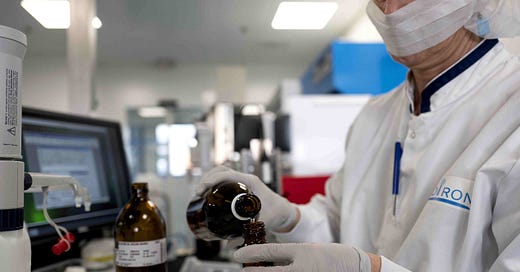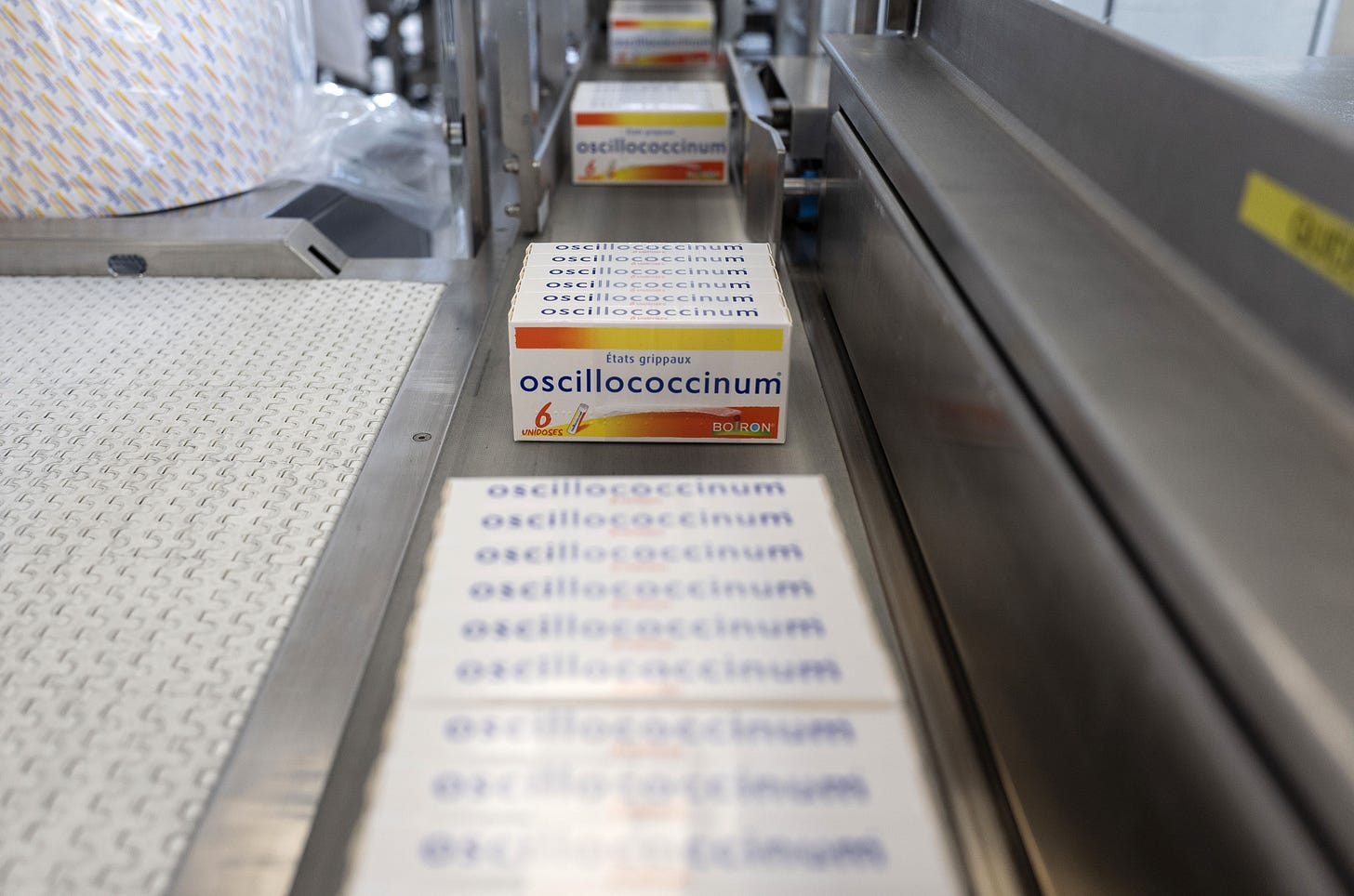Homeopathic Remedies are Often Made from Diseased Tissues and Discharges
They just hide behind magical names
Recently, I wrote about Good Clean Love Homeopathic Suppositories, explaining why the product is a scam based partially on the fact that the “active” ingredients are homeopathic (there are other scammy things as well). The post included a short description of homeopathy, explaining it is based on ideas not compatible with physics and that multiple studies have shown homeopathy is ineffective for every condition for which it has been tested.
And then something happened that made me go, “Huh.”
No, I didn’t start believing in homeopathy; rather, someone wrote a snarky note about the post on Instagram and tagged me:
“…saying homeopathy of any sort is a scam is some straight bs when many cultures have tons of homeopathic techniques that work.”
And it made me think of a conversation I’ve had in the office more than once. A patient will wonder if I can offer them a homeopathic medication, and so I ask them what they mean by that. I have never once had a patient explain homeopathy back to me correctly, meaning, “I want a therapy based on ‘like treats like’ that involves a substance so dilute what remains is water imbued with great power.” No, what they usually say is “natural,” “plant-based,” or “non-pharmaceutical.” Sometimes, they may even mean “ancient.” And given how homeopathy is advertised, it’s no wonder.
I then explain homeopathy, and universally, I receive a look of horror and a quick, “Oh, no, I don’t want that.”
What it seems most people are asking for when they say they want homeopathy is really a holistic therapy — one that considers them as a whole person. Then I explain how I approach illness — based on the best science we have, acknowledging the mind-body connection and supporting it, recommending a good baseline diet and exercise, and providing several different treatment options (including non-pharmaceutical if possible) so my patient can make the choice that works for them. After that explanation, I universally hear, “Oh, yes, that’s what I mean.”
I’ve also discussed homeopathy with non-medical friends, and like many of my patients, they believe the remedies are ground herbs or botanical extracts. So, I think many people really don’t know what homeopathy actually entails.
While natural, plant-based, non-pharmaceutical, from another culture, and ancient are not medically good reasons to use a product (and perhaps something to tackle at a future post), I think it would be helpful to expose these misconceptions and deceptions about homeopathy.
Homeopathy Is Not an Ancient Practice that Comes from Other Cultures
Homeopathy was invented by a German physician, Samuel Hahnemann, who received his medical degree in 1779 and apparently struggled financially for 15 or so years afterward. Toward the end of the century, he began to experiment with low doses of medicines, believing that if a drug or substance produced a mild form of the illness or symptoms like the illness, it could cure the illness. This is the “like treats like.” This is not consistent with any medical principle, but like all pseudoscience, it has a science-ish ring to it. You can see how it might resonate with people today. After all, we give tiny bits of viruses as vaccines. But Hahnemann’s “like treats like” was based on a very different concept. For example, syphilis causes ulcers, so small amounts of syphilis would be recommended to treat ulcers regardless of the cause.
Homeopathy Is Not Natural and Many of the Therapies are not from Plants
When most people think of natural, they mean ground-up herbs and other botanicals. Possibly a tea, but maybe a supplement or aloe vera.
While homeopathy remedies do sometimes start with a plant (for example, arnica, which apparently treats everything), many are nosodes, meaning their origin is diseased human or animal tissues or drainage from diseased tissues. Apparently, 95% of homeopaths think nosodes are important medical care. Here are some examples:
Luesinum (also called syphilinum) — made from syphilis, likely from an ulcer. According to the website abc homeopathy, its use is for “utter prostration and debility in the morning” as well as shifting rheumatic pains, hereditary tendency for alcoholism, and ulcers in the mouth, nose, and on the genitals.
Personally, I use coffee for my morning utter prostration and debility.
And then there is....
Lyssinum (also called lyssin or hydrophobium) — from the saliva of a rabid dog.
Lachesis — made from venom from a pit viper. This one is used for hot flushes (or hot flashes) in menopause. I’m not exactly sure how to frame a woman having hot flushes as being like a pit viper, it feels a tad misogynistic.
Tuberculinum — from a tuberculosis abscess.
Meningococcinum — apparently from tissue infected with Neisseria meningitidis. The tragic thing is homeopaths recommend this to parents instead of the vaccine.
But it’s not all pus and good times, some homeopathic remedies are made from more run-of-the-mill toxic substances
Mercurius Solubilis — what you get when you dissolve mercury metal in nitric acid
Causticum — blended slaked lime and sulphate of potash
Nitricum Acidum — nitric acid.
Recommending a pill with the memory of syphilis, tuberculosis pus, or mercury might be a bit off putting, so homeopathy switches up the names to make them sound as if the remedies are straight from Ye Olde Book of Potions and Incantations.
Rabies, syphilis, tuberculosis and the cast of infectious characters that make up nosodes are not plant based and neither are many other remedies, such as mercury or nitric acid. These non-botanicals make up a large part of the homeopathic cornucopia. Sure syphilis and mercury are found in nature, but I doubt this is what people are thinking of when they say they want a natural therapy.
Homeopathy Is Pharmaceutical
The Oxford English Dictionary defines pharmaceutical as “relating to the manufacture, use, or sale of medicinal drugs.”
Homeopathy is offered as medicinal. I mean, that is the point of taking it. For medical benefit.
Hahnemann introduced the dilution concept into homeopathy around 1814, initially proposing a dilution of one part in 100,000,000. Perhaps he realized that one could have too much “like,” meaning concoctions extracted from syphilis ulcers or tinctures or mercury were dangerous so he needed to dilute things a bit more. Well, a lot more.
Regardless of the reason for introducing dilutions, finding a botanical or pus extract or nitric acid in a homeopathic concentration in nature isn’t possible. It takes pharmaceutical effort to produce a homeopathic remedy. One drop of the original substance is placed in 100 drops of water, and then one drop of that solution is placed in another 100 drops of water. And then a drop from that solution...and so on 10 or 28 more times or whatever based on the dilution. The end result leaves no molecules behind, just a pill imbued with the “power” of the original substance.
Homeopathy isn’t a mom and pop business with the family doing dilutions in the back room, homeopathic dilutions are made in factories just like pharmaceuticals, although the latter actually has active ingredients. Homeopathy has sales of $4 billion a year globally. Boiron, the French homeopathic giant (see what I did there?) had sales of $674 million in 2018.
And Hahnemann, the father of it all, apparently retired rich in France like any good Pharma CEO.
So There You Have It…
Homeopathy is not ancient, it is a strange flex to call it natural (diluted syphilis extract anyone?), many therapies are not plant based, and it most definitely is pharmaceutical. Fortunately, for everyone who uses homeopathy it contains nothing. Makes you wonder exactly what those machines in the Boiron factory in France are doing? It’s quite the theater.
It’s your body and your choice and you should have all the information so you can make that choice an informed one. Knowing what homeopathy is, meaning it isn’t ancient, natural, or plant-based, and that it is a pharmaceutical is essential to making that informed choice.
And if homeopaths are so proud of their remedies, why hide the origin stories behind those magical names?





